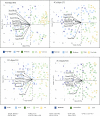Association mapping of autumn-seeded rye (Secale cereale L.) reveals genetic linkages between genes controlling winter hardiness and plant development
- PMID: 35388069
- PMCID: PMC8986816
- DOI: 10.1038/s41598-022-09582-2
Association mapping of autumn-seeded rye (Secale cereale L.) reveals genetic linkages between genes controlling winter hardiness and plant development
Abstract
Winter field survival (WFS) in autumn-seeded winter cereals is a complex trait associated with low temperature tolerance (LTT), prostrate growth habit (PGH), and final leaf number (FLN). WFS and the three sub-traits were analyzed by a genome-wide association study of 96 rye (Secale cereal L.) genotypes of different origins and winter-hardiness levels. A total of 10,244 single nucleotide polymorphism (SNP) markers were identified by genotyping by sequencing and 259 marker-trait-associations (MTAs; p < 0.01) were revealed by association mapping. The ten most significant SNPs (p < 1.49e-04) associated with WFS corresponded to nine strong candidate genes: Inducer of CBF Expression 1 (ICE1), Cold-regulated 413-Plasma Membrane Protein 1 (COR413-PM1), Ice Recrystallization Inhibition Protein 1 (IRIP1), Jasmonate-resistant 1 (JAR1), BIPP2C1-like protein phosphatase, Chloroplast Unusual Positioning Protein-1 (CHUP1), FRIGIDA-like 4 (FRL4-like) protein, Chalcone Synthase 2 (CHS2), and Phenylalanine Ammonia-lyase 8 (PAL8). Seven of the candidate genes were also significant for one or several of the sub-traits supporting the hypothesis that WFS, LTT, FLN, and PGH are genetically interlinked. The winter-hardy rye genotypes generally carried additional allele variants for the strong candidate genes, which suggested allele diversity was a major contributor to cold acclimation efficiency and consistent high WFS under varying field conditions.
© 2022. The Author(s).
Conflict of interest statement
The authors declare no competing interests.
Figures




References
-
- Schlegel RHJ. RYE. Genetics, Breeding, and Cultivation. Boca Raton: CRC Press; 2014.
-
- Bauer E, et al. Towards a whole-genome sequence for rye (Secale cereale L.) Plant J. 2017;89:853–869. - PubMed
Publication types
MeSH terms
LinkOut - more resources
Full Text Sources
Research Materials
Miscellaneous

